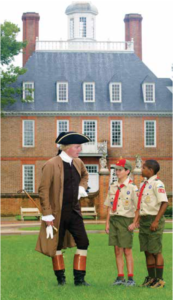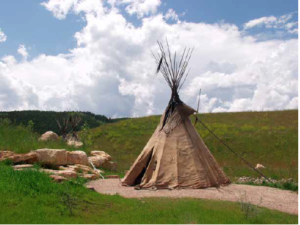Related Advancement
Advancement opportunities related to living history are numerous within the Scouting program. Pioneers and frontiersmen used basic Scoutcraft and outdoor skills on a daily basis just to survive. Be creative and look for connections.
American Cultures, American Heritage, Archery, Basketry, Communication, Cooking, Genealogy, Indian Lore, Leatherwork, Metalwork, Music and Bugling, Pioneering, Pottery, Rifle Shooting, Scouting Heritage, Wood Carving, and Woodwork merit badges
 First Person and Third Person
First Person and Third Person
Interpreters vary in the ways they display their knowledge of historical context. Some portray a character in the first person (in character), pretending to be a historical figure. Others stay in the 21st century—even though they may dress in period costumes—and describe historical events in the third person (out of character). Each approach has both advantages and disadvantages.
First-person interpreters use a persona, either a real historical figure or a fictional character. A fictional persona is usually a composite character who represents an average person from the time period.
Creating a Persona
As you develop a persona, consider these factors:
- You first need to decide what place and period you want to reenact. While you could choose any place and period, you will be better off starting with your local history because more resources will be available to you. You may also have more luck with heavily researched periods such as the Civil War.
- Developing a character can be as simple or as complex as you want to make it. It’s best to start simple and build upon the basics. What is your occupation? Are you a civilian or in the military? What year were you born, and where do you live? Are you a Native American, soldier, an immigrant, inventor, or an internment camp resident? Are you wealthy, poor, or somewhere in between? Answering these questions and more will help you determine what to wear, what equipment you may carry and use, and what type of daily activities you may likely do.
- If possible, resist the urge to reenact a historical figure because you will be bound to a much stricter level of accuracy. A fictional persona is far better for the novice reenactor as you have the flexibility to craft your persona into the person you want to be. (You should still strive for historical accuracy, of course.)
- Once you have decided on a character, research that time period and learn more about types of clothing, accoutrements, and occupations. From this information you can form a plan and develop your costume and a backstory.
Cooking
- One of the joys of Scouting is Dutch oven cooking. Living history lends itself very well to this style as cast iron cookware and Dutch ovens go back hundreds of years.
- Cooking over an open fire is an acquired skill, and learning those skills will further enhance your character presentation. Learn the difference between a cooking fire and a fire strictly for enjoyment and fellowship.
- Once you settle on a time period to reenact, you can research hundreds of period-correct foods and recipes, making your reenactment experience even more enjoyable. Observers will flock to you when you have some tasty foods for sampling.
- Historical cooking resources can be found at the library, online, and even on some television shows.
- Don’t be afraid to try foods that may not be the norm today. You may surprise yourself and learn to love those old recipes. They can also be healthful as they emphasize more vegetables and edible plants and rely less on processed ingredients from the grocery store.
- Recipes passed down through generations of families can also be a fun way to reconnect with your family’s past.
Living in the Outdoors
- Living in the outdoors in 1840, for example, is not so different from camping in the 21st century with the exception of the equipment used.
- Camp life can be as simple as a fur trapper’s primitive camp or as elaborate as a military brigade encampment. It all depends on the time period you are trying to represent. Attention to sanitation,
storage of food and water, and food preparation was as important 200 years ago as it is today. Do your research and prepare appropriately.
200 years ago as it is today. Do your research and prepare appropriately. - Put forth the effort to set up an accurate camp. Doing so will further enhance your reenactment experience, as well as educate others as to the lifestyle of a specific time and place. Look at your costume, persona, food, activities, and campsite as a complete package.
Firearms and Accoutrements
Certain living history time periods require the use of firearms, black powder, and accoutrements in order to accurately recreate that period. Examples include mountain man camps and Civil War reenactments.
Keep in mind that the policies in the Guide to Safe Scouting apply to living history activities just as they do for all Scouting activities. Another good resource is the National Shooting Sports Manual. Before undertaking any activity that uses firearms (aside from nonfunctioning replicas), consult with your council shooting sports coordinator or a BSA-certified shooting sports director.
One of the highlights of backpacking treks at Philmont Scout Ranch is hiking into a living history camp. At camps including Metcalf Station, Black Mountain, and Abreu, staff members interpret important periods in the history of the land that is now Philmont. Scouts who visit learn about that history and get the chance to try activities like blacksmithing, spar-pole climbing, and gold panning.